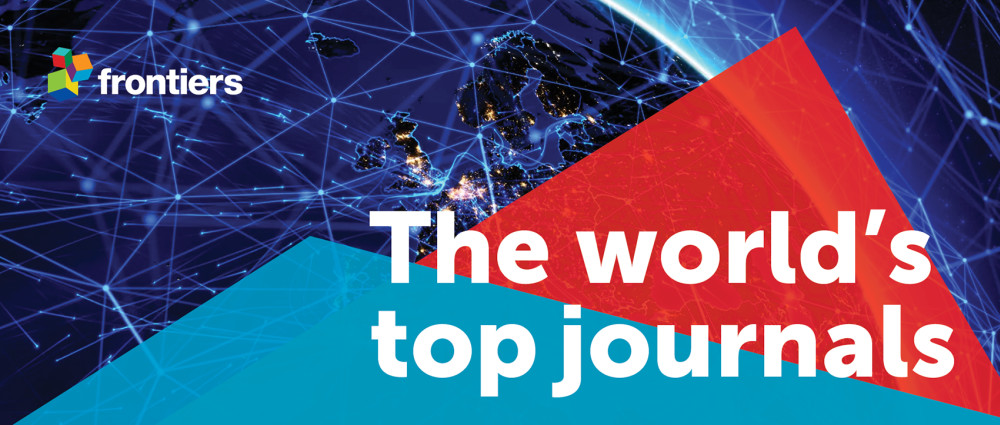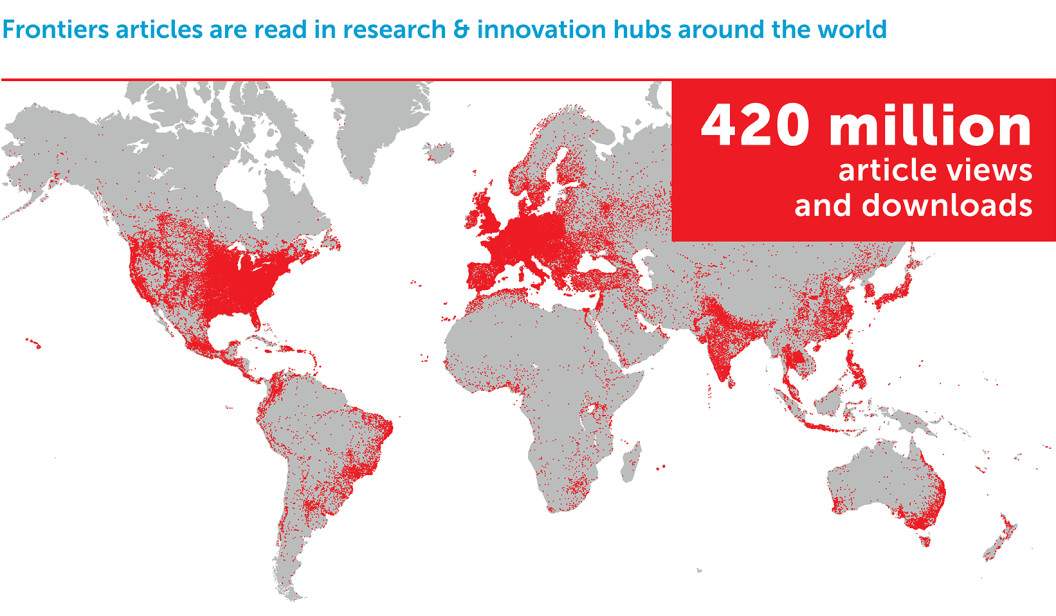- Science News
- Impact analysis
- Journal impact factors: Frontiers at the top of citation and impact metrics
Journal impact factors: Frontiers at the top of citation and impact metrics

Frontiers journals lead in citations & rank in the top Impact Factor and CiteScore percentiles
Frontiers journals rank among the world’s most-cited in their fields — including top most-cited in neurosciences, microbiology, plant science and psychology. In total, Frontiers articles have received more than 700,000 citations to date.
Our journals also have some of the highest citation rates. Among the world’s 20 largest publishers in 2017, Frontiers ranks 4th most-cited with an average of 3.65 citations per article.
Moreover, within each academic category our journals rank in the top Impact Factor and CiteScore percentiles.
Furthermore, Frontiers articles are highly visible at a global scale. To date, Frontiers articles have been viewed and downloaded more than 420 million times from research and innovation hubs around the world and mentioned 620,000 times in the news and social media.
All of this is only possible with a stellar editorial board of 80,000 researchers, our diligent and committed Associate and Review Editors, the dedicated Frontiers Journal Development Teams — and the amazing research of the 300,000 authors who have published in our journals, most of whom come from the world’s top 300 universities.
A heartfelt congratulations and thank you to everyone!
The world’s most-cited journals
Frontiers journals rank among the world’s most influential in terms of citations, as reported in the 2017 Journal Citation Reports (JCR; 2018, Clarivate Analytics, formerly Thomson Reuters) and 2017 CiteScore edition (2018, Scopus, Elsevier).
Notably:
The Frontiers in Neuroscience journal series is the most-cited in Neurosciences
Frontiers in Microbiology is the world’s most-cited Microbiology journal
Frontiers in Plant Science is the world’s most-cited Plant Sciences journal
Frontiers in Psychology is the world’s most-cited Multidisciplinary Psychology journal
Frontiers in Human Neuroscience is the world’s most-cited Psychology journal

Figure 1: Academic categories in which Frontiers journals rank in the top 3 in terms of total citations. Journal Citation Reports 2017 (JCR-2017) categories: Citation rankings based on total number of citations received in 2017 to articles published in 2015 and 2016 in the JCR-2017 (2018, Clarivate Analytics). Full data is shown in Figure 9. Citescore 2017 categories: Citation rankings based on total number of citations received in 2017 to articles published in 2014, 2015 and 2016 per academic category in the 2017 CiteScore edition (2018, Scopus, Elsevier), as well as for the Neuroscience subject area. Full data is shown in Figure 10. *Neurosciences: The ranking is calculated from total citations for all journals in the Frontiers in Neuroscience journal series, in the Neurosciences category (JCR-2017) and subject area (CiteScore 2017 edition). The Frontiers in Neuroscience journal series includes all Frontiers journals in the field of Neuroscience.

Figure 2: As of June 2018, Frontiers articles have received more than 700,000 citations (Scopus).
**Jump to:** What is journal impact? Journal citation analyses
Top citation rates
Articles published in Frontiers journals receive an average of 3.65 citations — the 4th-highest average citation rate among the world’s 20 largest academic journal publishers (Figure 3).

Figure 3: Analysis of the world’s 20 largest publishers by volume, ranked by number of average citations received to articles published in 2015, 2016 and 2017 (Scimago, 2018). Frontiers ranks 4th most-cited with an average of 3.65 citations per article. Read the full analysis here.
Our journals also rank in the top Impact Factor and CiteScore percentiles in their scientific fields. Of the 26 Frontiers journals indexed with an Impact Factor (JCR-2017, Clarivate Analytics 2018), 21 rank in the top 30% most impactful journals. Overall, our journals rank at the 72nd Impact Factor percentile on average and as high as the 91st percentile.

Figure 4: Analysis of Impact Factor rankings. A total of 11,655 journals are indexed in the 2017-JCR (released in 2018 by Clarivate Analytics). Of the 26 Frontiers journals listed in 23 JCR categories, 21 rank in the top 30% most impactful journals. Overall, Frontiers journals rank at the 72nd Impact Factor percentile on average and reach as high as the 91st percentile.
Similarly, of the 34 Frontiers journals with a 2017 CiteScore (Scopus, 2018), nine rank in the top 10% most impactful journals. Overall, our journals rank at the 84th CiteScore percentile on average and as high as the 95th percentile.

Figure 5: Analysis of CiteScore rankings. A total of 25,322 journals are indexed in the CiteScore 2017 edition (Scopus, 2018). The analysis here includes only the 22,472 journals with a full three-year publication history, that is, with published articles in 2015, 2016 and 2017. Of the 34 such Frontiers journals listed in 54 CiteScore categories, 9 rank in the top 10% most impactful journals. Overall, Frontiers journals rank at the 84th CiteScore percentile on average and as high as the 95th CiteScore percentile.
**Jump to:**► What are Impact Factor and CiteScore?► Impact Factor & CiteScore for Frontiers journals
Highly visible at a global scale
The quality and impact of research published in Frontiers journals is further indicated by continued growth in the number of articles published — with 64% from the world’s top 300 institutions.
These articles show broad readership both within and outside academic circles, with hundreds of millions of views and downloads from around the world and wide coverage in the media.

Figure 6: Data to June 2018 (Frontiers).

Figure 7: Data to June 2018 (Frontiers).

Figure 8: Data to June 2018 (altmetic.com).
What is journal impact?
Journal impact is traditionally measured via the number of citations received by the articles published within the journal. Journal Impact Factor and CiteScore are two indicators of journal quality while the influence of a journal on a field can be gauged by how much research is built on the papers published in the journal, as measured by the total number of citations.
What are article and author impact?
Frontiers additionally provides a wide array of real-time impact metrics that measure the overall performance and reach of articles and authors in an objective and crowd-sourced way. These include views and downloads, citations, social buzz (news and social media mentions, through altmetrics.com data) and visitor demographics like location, seniority and field of interest.
As opposed to journal metrics, article- and author-level metrics indicate the quality and global impact of individual articles, give credit to individual authors and allow article- and author-level comparisons.
What is the Impact Factor and CiteScore?
The Impact Factor is the average number of citations received in the last year to articles published in a journal for the previous two years. It is measured each year by Clarivate Analytics (formerly known as Thomson Reuters) and reported in the Journal Citation Reports (JCR). The 2017-JCR analysis is based on citations in 2017 to articles published in 2015 and 2016.
CiteScore is a similar metric covering titles in Elsevier’s Scopus database. The CiteScore number represents the average citations received in a specific year to articles published in the previous three years. The CiteScore 2017 edition is therefore based on citations in 2017 to articles published in 2014, 2015 and 2016. CiteScore was launched in December 2016 and is released once a year.
See Impact Factor & CiteScore for Frontiers journals
Journal citation analysis
Both the Journal Citation Reports and CiteScore metrics list citations — and our analysis of these figures shows that Frontiers journals rank among the most influential in their academic fields in terms of total citations.

Figure 9: Analysis of the top 10 most-cited journals in several JCR categories (JCR-2017, released in 2018 by Clarivate Analytics). Bar plots show the total number of citations in 2017 to articles published in 2015 and 2016, with Frontiers journals in red. Neurosciences: The ranking is calculated from total citations for all journals in the Frontiers in Neuroscience journal series, in the Neurosciences category (JCR-2017). The Frontiers in Neuroscience journal series includes all Frontiers journals in the field of Neuroscience.

Figure 10: Analysis of the top 10 most-cited journals in several 2017 CiteScore categories (released in 2018 by Scopus, Elsevier). Bar plots show the total number of citations in 2017 to articles published in 2014, 2015 and 2016, with Frontiers journals in red. Neurosciences: The ranking is calculated from total citations for all journals in the Frontiers in Neuroscience journal series, in the Neuroscience subject area (CiteScore 2017 edition). The Frontiers in Neuroscience journal series includes all Frontiers journals in the field of Neuroscience.
2018 Impact Factor and CiteScore by journal
Journal | 2018 CiteScore | 2018 Impact Factor |
Frontiers in Aging Neuroscience – | 3.96 | 3.582 |
Frontiers in Behavioral Neuroscience – | 3.43 | 3.138 |
4.36 | — | |
Frontiers in Cellular and Infection Microbiology – | 3.97 | 3.520 |
Frontiers in Cellular Neuroscience – | 4.45 | 4.300 |
4.36 | 4.155 | |
Frontiers in Computational Neuroscience – | 2.12 | 2.073 |
2.66 | — | |
– | 4.00 | 3.519 |
| 3.98 | — |
– | 3.78 | 4.151 |
Frontiers in Human Neuroscience – | 3.04 | 2.871 |
– | 5.62 | 5.511 |
Frontiers in Integrative Neuroscience – | 3.23 | — |
– | — | 2.008 |
2.89 | — | |
– | 4.19 | 4.019 |
3.32 | — | |
Frontiers in Molecular Neuroscience – | 4.34 | 3.902 |
– | 3.36 | 3.131 |
– | 3.33 | 3.152 |
– | 4.15 | 3.074 |
– | 3.28 | 3.508 |
– | 3.17 | 2.606 |
– | 3.94 | 3.877 |
– | 4.45 | 4.416 |
– | — | 2.335 |
– | 3.95 | 3.831 |
– | 3.66 | 3.394 |
– | 4.14 | 3.677 |
– | 3.14 | 2.857 |
– | 2.21 | 2.089 |
1.77 | — | |
Frontiers in Synaptic Neuroscience – | 3.31 | — |
Frontiers in Systems Neuroscience – | 3.79 | — |
1.94 | — |








